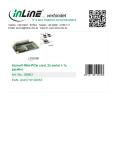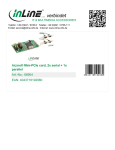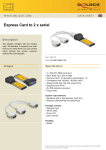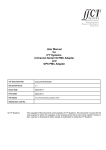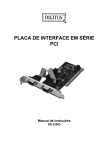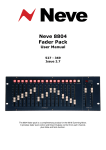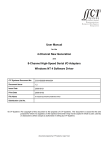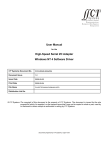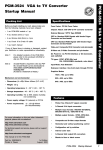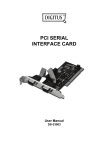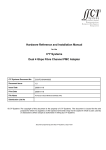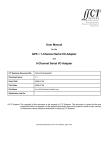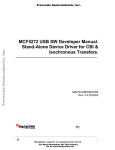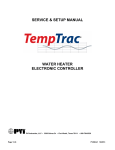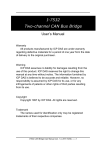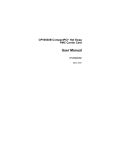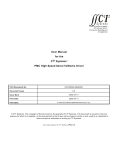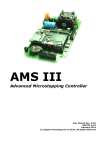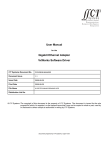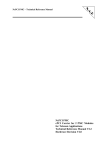Download User Manual for C²I² Systems 8-Channel Serial I/O PMC
Transcript
CCII Systems (Pty) Ltd Registration No. 1990/005058/07 C ommunications C omputer I ntellig ence I nteg ration User Manual for C²I² Systems 8-Channel Serial I/O PMC Adapter C²I² Systems Document No. CCII/LCP/6-MAN/003 Document Issue 1.1 Issue Date 2003-10-29 Print Date 2003-10-29 File Name W:\LCP\TECH\MAN\CLCMAN03.WPD Distribution List No © C²I² Systems The copyright of this document is the property of C²I² Systems. The document is issued for the sole purpose for which it is supplied, on the express terms that it may not be copied in whole or part, used by or disclosed to others except as authorised in writing by C²I² Systems. Document prepared by and for C²I² Systems, Cape Town Amendment History Issue Description Date ECP No. 0.1 First draft 2002-07-03 - 1.0 Updated to new template 2003-07-16 - 1.1 Added Ordering Information and Part Number of the Molex Front Panel Connector, Mating Connector and Ribbon Cable 2003-10-29 CCII/LCP/6-ECP/009 CCII/LCP/6-MAN/003 W:\LCP\TECH\MAN\CLCMAN03.WPD 2003-10-29 Issue 1.1 Page iii of v Contents 1. Introduction and Scope . . . . . . . . . . . . . . . . . . . . . . . . . . . . . . . . . . . . . . . . . . . . . . . . . . . . . 1 1.1 1.2 1.3 2. Applicable and Reference Documents . . . . . . . . . . . . . . . . . . . . . . . . . . . . . . . . . . . . . . . . . 2 2.1 2.2 2.3 3. Applicable Documents . . . . . . . . . . . . . . . . . . . . . . . . . . . . . . . . . . . . . . . . . . . . . . . . . . . . . . . . . . . . . . . . . 2 Reference Documents . . . . . . . . . . . . . . . . . . . . . . . . . . . . . . . . . . . . . . . . . . . . . . . . . . . . . . . . . . . . . . . . . 2 Specifications . . . . . . . . . . . . . . . . . . . . . . . . . . . . . . . . . . . . . . . . . . . . . . . . . . . . . . . . . . . . . . . . . . . . . . . . 2 PMC/PCI Interface . . . . . . . . . . . . . . . . . . . . . . . . . . . . . . . . . . . . . . . . . . . . . . . . . . . . . . . . . 3 3.1 3.2 3.3 3.4 3.5 4. Scope . . . . . . . . . . . . . . . . . . . . . . . . . . . . . . . . . . . . . . . . . . . . . . . . . . . . . . . . . . . . . . . . . . . . . . . . . . . . . . 1 Introduction . . . . . . . . . . . . . . . . . . . . . . . . . . . . . . . . . . . . . . . . . . . . . . . . . . . . . . . . . . . . . . . . . . . . . . . . . 1 System Overview . . . . . . . . . . . . . . . . . . . . . . . . . . . . . . . . . . . . . . . . . . . . . . . . . . . . . . . . . . . . . . . . . . . . . 1 Overview . . . . . . . . . . . . . . . . . . . . . . . . . . . . . . . . . . . . . . . . . . . . . . . . . . . . . . . . . . . . . . . . . . . . . . . . . . . 3 Configuration Space . . . . . . . . . . . . . . . . . . . . . . . . . . . . . . . . . . . . . . . . . . . . . . . . . . . . . . . . . . . . . . . . . . 3 PCI Interrupts . . . . . . . . . . . . . . . . . . . . . . . . . . . . . . . . . . . . . . . . . . . . . . . . . . . . . . . . . . . . . . . . . . . . . . . . 4 PMC Connectors . . . . . . . . . . . . . . . . . . . . . . . . . . . . . . . . . . . . . . . . . . . . . . . . . . . . . . . . . . . . . . . . . . . . . 4 PMC Pin Assignments . . . . . . . . . . . . . . . . . . . . . . . . . . . . . . . . . . . . . . . . . . . . . . . . . . . . . . . . . . . . . . . . . 5 Serial Interface . . . . . . . . . . . . . . . . . . . . . . . . . . . . . . . . . . . . . . . . . . . . . . . . . . . . . . . . . . . . 8 4.1 4.2 4.3 4.4 Overview . . . . . . . . . . . . . . . . . . . . . . . . . . . . . . . . . . . . . . . . . . . . . . . . . . . . . . . . . . . . . . . . . . . . . . . . . . . 8 Line Driver Selection . . . . . . . . . . . . . . . . . . . . . . . . . . . . . . . . . . . . . . . . . . . . . . . . . . . . . . . . . . . . . . . . . 10 Memory Map . . . . . . . . . . . . . . . . . . . . . . . . . . . . . . . . . . . . . . . . . . . . . . . . . . . . . . . . . . . . . . . . . . . . . . . 11 UART Register Description . . . . . . . . . . . . . . . . . . . . . . . . . . . . . . . . . . . . . . . . . . . . . . . . . . . . . . . . . . . . 13 4.4.1 Transmitter Holding Register (THR) . . . . . . . . . . . . . . . . . . . . . . . . . . . . . . . . . . . . . . . . . . . . . . . 13 4.4.2 Receive Holding Register (RHR) . . . . . . . . . . . . . . . . . . . . . . . . . . . . . . . . . . . . . . . . . . . . . . . . . 13 4.4.3 Interrupt Enable Register (IER) . . . . . . . . . . . . . . . . . . . . . . . . . . . . . . . . . . . . . . . . . . . . . . . . . . 13 4.4.4 Interrupt Identification Register (IIR) . . . . . . . . . . . . . . . . . . . . . . . . . . . . . . . . . . . . . . . . . . . . . . . 14 4.4.5 FIFO Control Register (FCR) . . . . . . . . . . . . . . . . . . . . . . . . . . . . . . . . . . . . . . . . . . . . . . . . . . . . 16 4.4.6 Line Control Register (LCR) . . . . . . . . . . . . . . . . . . . . . . . . . . . . . . . . . . . . . . . . . . . . . . . . . . . . . 17 4.4.7 Modem Control Register (MCR) . . . . . . . . . . . . . . . . . . . . . . . . . . . . . . . . . . . . . . . . . . . . . . . . . . 18 4.4.8 Line Status Register (LSR) . . . . . . . . . . . . . . . . . . . . . . . . . . . . . . . . . . . . . . . . . . . . . . . . . . . . . . 19 4.4.9 Modem Status Register (MSR) . . . . . . . . . . . . . . . . . . . . . . . . . . . . . . . . . . . . . . . . . . . . . . . . . . . 20 4.4.10 Scratch Pad Register (SPR) . . . . . . . . . . . . . . . . . . . . . . . . . . . . . . . . . . . . . . . . . . . . . . . . . . . . . 21 4.4.11 Programmable Baud-Rate Generator . . . . . . . . . . . . . . . . . . . . . . . . . . . . . . . . . . . . . . . . . . . . . . 22 4.4.12 FIFO Interrupt Mode Operation . . . . . . . . . . . . . . . . . . . . . . . . . . . . . . . . . . . . . . . . . . . . . . . . . . 22 4.4.13 Register Reset Conditions . . . . . . . . . . . . . . . . . . . . . . . . . . . . . . . . . . . . . . . . . . . . . . . . . . . . . . 23 Appendix A . . . . . . . . . . . . . . . . . . . . . . . . . . . . . . . . . . . . . . . . . . . . . . . . . . . . . . . . . . . . . . . . . 24 MOLEX Connector Pin Locations and Ordering Information . . . . . . . . . . . . . . . . . . . . . . . . . . . . . . . . . . . . . . . . . 24 CCII/LCP/6-MAN/003 W:\LCP\TECH\MAN\CLCMAN03.WPD 2003-10-29 Issue 1.1 Page iv of v Abbreviations and Acronyms BIST CCII Built In Self Test Register CCII Systems (Pty) LTD CD Carrier Detect CS Chip Select CTS Clear to Send DSR Data Set Ready DTR Data Terminal Ready FIFO First In First Out memory structure I/O Input / Output INT Interrupt IRQ Interrupt Request LSB Least Significant Bit MSB Most Significant Bit PCI Peripheral Component Interconnect PMC PCI Mezzanine Card RI Ring Indicator RTS Request To Send RX Receive TX Transmit UART Universal Asynchronous Receiver Transmitter CCII/LCP/6-MAN/003 W:\LCP\TECH\MAN\CLCMAN03.WPD 2003-10-29 Issue 1.1 Page v of v 1. Introduction and Scope 1.1 Scope This document serves as a user manual for C²I² Systems 8-Channel Serial I/O PMC Adapter. 1.2 Introduction The 8-Channel Serial I/O PMC Adapter provides eight full duplex, asynchronous serial ports. All eight ports are capable of transmitting and receiving data using either RS-232 or RS-422/485 standards. The 8-Channel Serial I/O PMC Adapter adheres to the electrical requirements of the PCI interface specification and to the mechanical requirements of the PMC interface standard. 1.3 System Overview The block diagram of the adapter is shown in Figure 1. PMC Bus Configuration EEPROM (optional) Channel 1 8-Channel UART with PCI Interface Channel 8 User Selectable RS-232/RS-422 Level Converter User Selectable RS-232/RS-422 Level Converter Serial I/O Serial I/O Bus Mode PAL Figure 1 : Block diagram of the 8-Channel Serial I/O PMC Adapter CCII/LCP/6-MAN/003 W:\LCP\TECH\MAN\CLCMAN03.WPD 2003-10-29 Issue 1.1 Page 1 of 26 2. Applicable and Reference Documents 2.1 Applicable Documents None 2.2 Reference Documents None 2.3 Specifications 2.3.1 PCI Local Bus Specification, Revision 2.1, Dated June 1, 1995 2.3.2 Draft Standard Physical and Environmental Layers for PCI Mezzanine Cards : PMC, P1386.1/Draft 2.0, Dated April 4, 1995 2.3.3 Draft Standard for a Common Mezzanine Card Family : CMC, P1386/Draft 2.0, Dated April 4, 1995 CCII/LCP/6-MAN/003 W:\LCP\TECH\MAN\CLCMAN03.WPD 2003-10-29 Issue 1.1 Page 2 of 26 3. PMC/PCI Interface 3.1 Overview The 8-Channel Serial I/O PMC Adapter conforms to the PMC interface specification which is based on the PCI bus interface standard. The PMC interface standard defines the physical and environmental aspects of the PCI mezzanine card interface. The 8-Channel Serial I/O PMC Adapter implements a single width module that can provide I/O through either a 120 pin MOLEX front panel connector (Refer to Appendix A for part number and ordering information) or through the back plane connector. The PCI interface standard defines the electrical aspects of the interface. The 8-Channel Serial I/O PMC Adapter provides a PCI compliant slave interface allowing the host board to transfer data to and from the serial interface controller. The PCI interface is implemented using a PCI based eight-channel UART bridge. 3.2 Configuration Space The PCI interface defines a standard programming model for the configuration of PCI devices. This interface is defined as the Configuration Space. The table below shows the Configuration Space as defined by the PCI bus specification : AD31-23 AD22-16 AD15-8 AD7-0 Address Device ID(0x0158) Vendor ID(0x13AB) 0x00 Status Command 0x04 Class Code(0x070002) BIST Header Type Latency Timer 0x08 Cache Size(0x00) 0x0C Memory Base Address Register (BAR) 0x10 Unimplemented Base Address Register 0x14 Unimplemented Base Address Register 0x18 Unimplemented Base Address Register 0x1C Unimplemented Base Address Register 0x20 Unimplemented Base Address Register 0x24 Reserved 0x28 Subsystem ID Max Latency(0x00) Revision ID(0x01) Subsystem Vendor ID 0x2C Reserved 0x30 Reserved 0x34 Reserved 0x38 Min Grant(0x00) Interrupt Pin(0x01) Interrupt Line 0x3C The location of the configuration registers is defined by the host board. The host board assigns a specific address line to the module interface by connecting it to the IDSEL pin on the PMC interface. To determine the configuration registers locations refer to the manual of the host board. CCII/LCP/6-MAN/003 W:\LCP\TECH\MAN\CLCMAN03.WPD 2003-10-29 Issue 1.1 Page 3 of 26 3.3 PCI Interrupts The 8-Channel Serial I/O PMC Adapter supports interrupts on the INTA# pin only. This is reflected in the Interrupt Pin Register of the Configuration Space as defined in 3.2. 3.4 PMC Connectors The 8-Channel Serial I/O PMC Adapter is fitted with two connectors (P11 and P12) to implement the 32-bit PMC interface. The board may be fitted with a either connector P14 (required for back plane connection to the interface signals) or the front panel connector (J2). The front and rear panel configurations are shown in Figure 2 and Figure 3 respectively. J2 P11 P12 Figure 2 : Front panel I/O Configuration P14 P11 P12 Figure 3 : Rear Panel I/O Configuration CCII/LCP/6-MAN/003 W:\LCP\TECH\MAN\CLCMAN03.WPD 2003-10-29 Issue 1.1 Page 4 of 26 3.5 PMC Pin Assignments The 8-Channel Serial I/O PMC Adapter has the following PMC connections (note that P14 is only for the rear panel configuration) : P11 Signals Pin Signal Name Signal Name Pin 1 TCK -12V 2 3 Ground INTA# 4 5 INTB# INTC# 6 7 BUSMODE1# +5V 8 9 INTD# PCI-RSVD 10 11 Ground PCI-RSVD 12 13 CLK Ground 14 15 Ground GNT# 16 17 REQ# +5V 18 19 V (I/O) AD[31] 20 21 AD[28] AD[27] 22 23 AD[25] Ground 24 25 Ground C/BE[3]# 26 27 D[22] AD[21] 28 29 AD[19] +5V 30 31 V (I/O) AD[17] 32 33 FRAME# Ground 34 35 Ground IRDY# 36 37 DEVSEL# +5V 38 39 Ground LOCK# 40 41 SDONE# SBO# 42 43 PAR Ground 44 45 V (I/O) AD[15] 46 47 AD[12] AD[11] 48 49 AD[09] +5V 50 51 Ground C/BE[0]# 52 53 AD[06] AD[05] 54 55 AD[04] Ground 56 57 V (I/O) AD[03] 58 59 AD[02] AD[01] 60 61 AD[00] +5V 62 63 Ground REQ64# 64 CCII/LCP/6-MAN/003 W:\LCP\TECH\MAN\CLCMAN03.WPD 2003-10-29 Issue 1.1 Page 5 of 26 P12 Signals Pin Signal Name Signal Name Pin 1 +12V TRST# 2 3 TMS TDO 4 5 TDI Ground 6 7 Ground PCI-RSVD 8 9 PCI-RSVD PCI-RSVD 10 11 BUSMODE2# +3.3V 12 13 RST# BUSMODE3# 14 15 +3.3V BUSMODE4# 16 17 PCI-RSVD Ground 18 19 AD[30] AD[29] 20 21 Ground AD[26] 22 23 AD[24] +3.3V 24 25 IDSEL AD[23] 26 27 +3.3V AD[20] 28 29 AD[18] Ground 30 31 AD[16] C/BE[2]# 32 33 Ground PMC-RSVD 34 35 TRDY# +3.3V 36 37 Ground STOP# 38 39 PERR# Ground 40 41 +3.3V SERR# 42 43 C/BE[1]# Ground 44 45 AD[14] AD[13] 46 47 Ground AD[10] 48 49 AD[08] +3.3V 50 51 AD[07] PMC-RSVD 52 53 +3.3V PMC-RSVD 54 55 PMC-RSVD Ground 56 57 PMC-RSVD PMC-RSVD 58 59 Ground PMC-RSVD 60 61 ACK64# +3.3V 62 63 Ground PMC-RSVD 64 CCII/LCP/6-MAN/003 W:\LCP\TECH\MAN\CLCMAN03.WPD 2003-10-29 Issue 1.1 Page 6 of 26 P14 Signals ( Rear Panel Configuration Only ) Pin Signal Name RS-232 Signal Name RS-422 RS-232 Pin RS-422 1 TX_A TX+_A RTS_A TX-_A 2 3 DTR_A RTS+_A RX_A RTS-_A 4 5 CTS_A RX+_A DSR_A RX-_A 6 7 CD_A CTS+_A RI_A CTS-_A 8 9 TX_A TX+_A RTS_A TX-_A 10 11 DTR_B RTS+_B RX_B RTS-_B 12 13 CTS_B RX+_B DSR_B RX-_B 14 15 CD_B CTS+_B RI_B CTS-_B 16 17 TX_C TX+_C RTS_C TX-_C 18 19 DTR_C RTS+_C RX_C RTS-_C 20 21 CTS_C RX+_C DSR_C RX-_C 22 23 CD_C CTS+_C RI_C CTS-_C 24 25 TX_D TX+_D RTS_D TX-_D 26 27 DTR_D RTS+_D RX_D RTS-_D 28 29 CTS_D RX+_D DSR_D RX-_D 30 31 CD_D CTS+_D RI_D CTS-_D 32 33 TX_E TX+_E RTS_E TX-_E 34 35 DTR_E RTS+_E RX_E RTS-_E 36 37 CTS_E RX+_E DSR_E RX-_E 38 39 CD_E CTS+_E RI_E CTS-_E 40 41 TX_F TX+_F RTS_F TX-_F 42 43 DTR_F RTS+_F RX_F RTS-_F 44 45 CTS_F RX+_F DSR_F RX-_F 46 47 CD_F CTS+_F RI_F CTS-_F 48 49 TX_G TX+_G RTS_G TX-_G 50 51 DTR_G RTS+_G RX_G RTS-_G 52 53 CTS_G RX+_G DSR_G RX-_G 54 55 CD_G CTS+_G RI_G CTS-_G 56 57 TX_H TX+_H RTS_H TX-_H 58 59 DTR_H RTS+_H RX_H RTS-_H 60 61 CTS_H RX+_H DSR_H RX-_H 62 63 CD_H CTS+_H RI_H CTS-_H 64 Note : P14 Signals are configured such that the adapter channels function as Data Terminal Equipment (DTE). This specifies the I/O direction of the adapter’s signals as follows : • • • • • • • • TxD is an output RxD is an input RTS is an output CTS is an input DTR is an output DSR is an input RI is an input CD is an input CCII/LCP/6-MAN/003 W:\LCP\TECH\MAN\CLCMAN03.WPD 2003-10-29 Issue 1.1 Page 7 of 26 4. Serial Interface 4.1 Overview The 8-Channel Serial I/O PMC Adapter has eight asynchronous, RS-232 or RS-422/485 switchable serial ports. Programming registers for these ports are compatible with the 16C550 UART. Each ports is configured by DIP switches located on the PMC Adapter board. On the rear panel PMC Adapter, the signals are available at P14 as detailed in 3.5. On the front panel PMC Adapter, the signals are available at J2 as shown in 3.4. J2 is a 120 pin shielded right angle connector manufactured by MOLEX (Refer to Appendix A for part number and ordering information). The pinout is as show in the table below (see Appendix A for the physical pin locations). J2 Signals ( Front Panel Configuration Only ) Pin Signal Name RS-232 Signal Name RS-422 RS-232 Pin RS-422 Port A 2 TX_A TX+_A RTS_A TX-_A 4 6 DTR_A RTS+_A RX_A RTS-_A 8 10 CTS_A RX+_A DSR_A RX-_A 12 14 CD_A CTS+_A RI_A CTS-_A 16 18 DTR+_A DTR-_A 20 22 DSR+_A DSR-_A 24 26 CD+_A CD-_A 28 Port B 30 TX_B TX+_B RTS_B TX-_B 1 3 DTR_B RTS+_B RX_B RTS-_B 5 7 CTS_B RX+_B DSR_B RX-_B 9 11 CD_B CTS+_B RI_B CTS-_B 13 15 DTR+_B DTR-_B 17 19 DSR+_B DSR-_B 21 23 CD+_B CD-_B 25 Port C 27 TX_C TX+_C RTS_C TX-_C 29 32 DTR_C RTS+_C RX_C RTS-_C 34 36 CTS_C RX+_C DSR_C RX-_C 38 40 CD_C CTS+_C RI_C CTS-_C 42 44 DTR+_C DTR-_C 46 48 DSR+_C DSR-_C 50 52 CD+_C CD-_C 54 RTS_D TX-_D 58 Port D 56 TX_D TX+_D 60 DTR_D RTS+_D RX_D RTS-_D 31 33 CTS_D RX+_D DSR_D RX-_D 35 37 CD_D CTS+_D RI_D CTS-_D 39 41 DTR+_D DTR-_D 43 45 DSR+_D DSR-_D 47 49 CD+_D CD-_D 51 Port E CCII/LCP/6-MAN/003 W:\LCP\TECH\MAN\CLCMAN03.WPD 2003-10-29 Issue 1.1 Page 8 of 26 53 TX_E TX+_E RTS_E TX-_E 57 DTR_E 62 CTS_E 66 CD_E 55 RTS+_E RX_E RTS-_E 59 RX+_E DSR_E RX-_E 64 CTS+_E RI_E CTS-_E 68 70 DTR+_E DTR-_E 72 74 DSR+_E DSR-_E 76 78 CD+_E CD-_E 80 Port F 82 TX_F TX+_F RTS_F TX-_F 84 86 DTR_F RTS+_F RX_F RTS-_F 88 90 CTS_F RX+_F DSR_F RX-_F 61 63 CD_F CTS+_F RI_F CTS-_F 65 67 DTR+_F DTR-_F 69 71 DSR+_F DSR-_F 73 75 CD+_F CD-_F 77 Port G 79 TX_G TX+_G RTS_G TX-_G 81 83 DTR_G RTS+_G RX_G RTS-_G 85 87 CTS_G RX+_G DSR_G RX-_G 89 92 CD_G CTS+_G RI_G CTS-_G 94 96 DTR+_G DTR-_G 98 100 DSR+_G DSR-_G 102 104 CD+_G CD-_G 106 Port H 108 TX_H TX+_H RTS_H TX-_H 110 112 DTR_H RTS+_H RX_H RTS-_H 114 116 CTS_H RX+_H DSR_H RX-_H 118 120 CD_H CTS+_H RI_H CTS-_H 91 95 93 DTR+_H DTR-_H 97 DSR+_H DSR-_H 99 101 CD+_H CD-_H 103 105 107 109 111 113 GROUND GROUND 115 117 GROUND GROUND 119 Note : J2 Signals are configured such that the adapter channels function as Data Terminal Equipment (DTE). This specifies the I/O direction of the adapter’s signals as follows : • • • • • • • • TxD is an output RxD is an input RTS is an output CTS is an input DTR is an output DSR is an input RI is an input CD is an input CCII/LCP/6-MAN/003 W:\LCP\TECH\MAN\CLCMAN03.WPD 2003-10-29 Issue 1.1 Page 9 of 26 4.2 Line Driver Selection All eight channels can be individually configured to use RS-232 or RS-422/485 line drivers. This is achieved by setting the appropriate DIP switches located on the 8-Channel Serial I/O PMC Adapter as shown in Figure 4: P1 2 P1 1 J 2 ON ON ON ON ON Figure 4 : DIP Switch Location S4 is used to select between RS-232 and RS-422/485 line drivers for channels A-H. When switched to the ON position, RS-232 line drivers are selected, otherwise RS-422/485 line drivers are selected. S1, S2, S3 and S5 are used to switch in 100 Ω line termination resistors required for RS-422/485 receivers. When switched to the ON position, the line termination is switched in. It is crucial that these termination resistors NOT be switched in when RS-232 drivers have been selected on S4 (in other words, these switches must not be in the ON position when RS-232 line drivers have been selected). CCII/LCP/6-MAN/003 W:\LCP\TECH\MAN\CLCMAN03.WPD 2003-10-29 Issue 1.1 Page 10 of 26 4.3 Memory Map The memory map for the device configuration registers are given in the table below : Offset Address Memory Space Read/Write Comment 0x000 - 0x007 UART channel A registers 16C550 compatible 0x100 UART A - Read FIFO Read-Only 64 bytes of RX FIFO 0x100 UART A - Write FIFO Write-Only 64 bytes of TX FIFO 0x200 - 0x207 UART channel B registers 0x300 UART B - Read FIFO Read-Only 64 bytes of RX FIFO 0x300 UART B - Write FIFO Write-Only 64 bytes of TX FIFO 0x400 - 0x407 UART channel C registers 0x500 UART C - Read FIFO Read-Only 64 bytes of RX FIFO 0x500 UART C - Write FIFO Write-Only 64 bytes of TX FIFO 0x600 - 0x607 UART channel D registers 0x700 UART D - Read FIFO Read-Only 64 bytes of RX FIFO 0x700 UART D - Write FIFO Write-Only 64 bytes of TX FIFO 16C550 compatible 16C550 compatible 16C550 compatible 0x800 - 0x807 UART channel E registers 0x900 UART E - Read FIFO Read-Only 64 bytes of RX FIFO 16C550 compatible 0x900 UART E - Write FIFO Write-Only 64 bytes of TX FIFO 0xA00 - 0xA07 UART channel F registers 0xB00 UART F - Read FIFO Read-Only 16C550 compatible 64 bytes of RX FIFO 0xB40 - 0xB7F UART F - Write FIFO Write-Only 64 bytes of TX FIFO 0xC00 - 0xC07 UART channel G registers 0xD00 UART G - Read FIFO Read-Only 64 bytes of RX FIFO 0xD00 UART G - Write FIFO Write-Only 64 bytes of TX FIFO 0xE00 - 0xE07 UART channel H registers 0xF00 UART H - Read FIFO Read-Only 64 bytes of RX FIFO 0xF00 UART H - Write FIFO Write-Only 64 bytes of TX FIFO CCII/LCP/6-MAN/003 W:\LCP\TECH\MAN\CLCMAN03.WPD 2003-10-29 16C550 compatible 16C550 compatible Issue 1.1 Page 11 of 26 The UART channel configuration registers, which are 16C550 compatible, are given in the table below : LCR[7] = 0 LCR[7] = 1 I/O Port Read Write Read Base RBR Receiver Buffer THR Transmit Holding DLL Divisor Latch (LSB) Base + 1 IER Interrupt Enable Base + 2 IIR Interrupt Identification DLM Divisor Latch (MSB) FCR FIFO Control IIR Interrupt Identification Base + 3 LCR Line Control Base + 4 MCR Modem Control Base + 5 LSR Line Status Base + 6 MSR Modem Status NOT USED MSR Modem Status Base + 7 W:\LCP\TECH\MAN\CLCMAN03.WPD FCR FIFO Control LSR Line Status NOT USED CCII/LCP/6-MAN/003 Write SPR Scratch Pad 2003-10-29 Issue 1.1 Page 12 of 26 4.4 UART Register Description 4.4.1 Transmitter Holding Register (THR) The transmitter section consists of a transmitter holding register (THR) and a transmitter shift register (TSR). The THR is actually a 16-byte FIFO. Transmitter section control is a function of the UART line control register. The UART THR receives data off the internal data bus and when the shift register is idle, moves it into the TSR. The TSR serializes the data and outputs it at TX. In the 16C450 mode, if the THR is empty and the transmitter holding register empty (THRE) interrupt is enabled (IER[1] = 1), an interrupt is generated. This interrupt is cleared when a character is loaded into the register. In the FIFO mode, the interrupts are generated based on the control setup in the FIFO control register. 4.4.2 Receive Holding Register (RHR) The receiver section of the UART consists of a receiver shift register (RSR) and a receiver Holding register (RHR). The RHR is actually a 16-byte FIFO. Timing to receive holding register is supplied by the 16x receiver clock. Receiver section control is a function of the UART line control register. The UART RHR receives serial data from RX. The RSR then concatenates the data and moves it into the RHR FIFO. In the 16C450 mode, when a character is placed in the receiver holding register and the received data available interrupt is enabled (IER[0] = 1), an interrupt is generated. This interrupt is cleared when the data is read out of the receiver holding register. In the FIFO mode, the interrupts are generated based on the control setup in the FIFO control register. 4.4.3 Interrupt Enable Register (IER) The interrupt enable register enables each of the five types of interrupts and INT pin response to an interrupt generation. The interrupt enable register can also be used to disable the interrupt system by clearing IER[0..3]. The contents of this register are described below. IER[0] : 0 = Disable the received data available interrupt. 1 = Enables the received data available interrupt. IER[1] : 0 = Disable the transmitter holding register empty interrupt. 1 = Enable the transmitter holding register empty interrupt. IER[2] : 0 = Disables the receiver line status interrupt. 1 = Enables the receiver line status interrupt. IER[3] : 0 = Disables the modem status interrupt. 1 = Enables the modem status interrupt. IER[4] : 0 = Standard 16C450/550 mode. Sleep mode is disabled. 1 = Enables sleep mode. The UART is always awake when there is a byte in the transmitter, activity on the RX, or either Delta CTS, Delta DSR, Delta CD, Delta RI is/are set to logic "1", or when the device is in the loopback mode. IER[5] : 0 = Standard 16C450/550 mode. Power down mode is disabled. 1 = Enables the power down mode. Power down mode functions similar to sleep mode (except oscillator section). CCII/LCP/6-MAN/003 W:\LCP\TECH\MAN\CLCMAN03.WPD 2003-10-29 Issue 1.1 Page 13 of 26 IER[6..7] : These bits are not used (always set to 0). 4.4.4 Interrupt Identification Register (IIR) The UART has an on chip interrupt generation and prioritization capability. IIR[0] : 0 = An interrupt is pending. Used either in a hardware prioritized or polled interrupt system. 1 = No interrupt is pending. IIR[1..2] : The UART provides four prioritized levels of interrupts : Priority 1 - Receiver line status (highest priority) Priority 2 - Receiver data ready Priority 2 - Receiver character time-out Priority 3 - Transmitter holding register empty Priority 4 - Modem status (lowest priority) When an interrupt is generated, the interrupt identification register indicates that an interrupt is pending and encodes the type of interrupt in its three least significant bits (IIR[0..2]). Interrupt Priority decode IIR[3] IIR[2] IIR[1] IIR[0] Interrupt source 0 1 1 0 Receive Data Error 0 1 0 0 Receive Data Ready 1 1 0 0 Receive Time-Out 0 0 1 0 Transmit Holding Empty 0 0 0 0 Modem Status Change These bits are used to identify the highest priority interrupt pending. IIR[0] will be set when no interrupt is pending. To clear the interrupts it is necessary to perform reads from the following registers as required. Receive Data Error : Reading LSR register will clear this interrupt. User should save LSR value after reading the register to maintain the error condition. Receive Data Ready : Reading RHR register till FIFO becomes empty. Receive Timeout : Reading entire characters from RHR. Transmit Holding Empty : Writing a character into THR register or reading IIR register (if source of interrupt). Modem Status Change : Reading MSR register will clear this interrupt. IIR[3] : 0 = In the 16C450 mode. In FIFO mode, this bit is set along with IIR[2] to indicate that a time-out interrupt is pending. CCII/LCP/6-MAN/003 W:\LCP\TECH\MAN\CLCMAN03.WPD 2003-10-29 Issue 1.1 Page 14 of 26 IIR[4] : This bit is not used (always reset at 0). IIR[5] : 0 = 16C450/550 mode, 16 byte FIFO mode. 1 = Enhance FIFO mode. 64 byte FIFO mode enabled. IIR[6..7] : 0 = In the 16C450 mode. 1 = When FCR[0] is set. CCII/LCP/6-MAN/003 W:\LCP\TECH\MAN\CLCMAN03.WPD 2003-10-29 Issue 1.1 Page 15 of 26 4.4.5 FIFO Control Register (FCR) The FIFO control register (FCR) is a write only register. The (FCR) enables and clears the FIFO sets receive FIFO trigger level, and selects the type of DMA signaling. FCR[0] : 0 = 16C450 mode, disables the transmitter and receiver FIFO. 1 = Enables the transmitter and receiver FIFO. This bit must be set to 1 when other (FCR) bits are written to or they are not programmed. Changing this bit clears the FIFO. FCR[1] : 0 = Normal operation 1 = Clears all bytes in the receiver FIFO and resets its counter logic to 0. The shift register is not cleared. The 1 that is written to this bit position is self-clearing. FCR[2] : 0 = Normal operation 1 = Clears all bytes in the transmit FIFO and resets its counter logic to 0. The shift register is not cleared. The 1 that is written to this bit position is self-clearing. FCR[3] : 0 = Mode 0 : Supports single transfer DMA (16C450 mode) in which a transfer is made between Host bus cycle. 1 = Mode 1 : Supports multi transfer DMA in which multiple transfers are made continuously until the receiver FIFO has been emptied. FCR[5..4] : These bits are not used. FCR[6..7] : These bits are used to set the trigger level for receive FIFO interrupt. Receive Trigger Levels (Bytes) FCR[7] FCR[6] RX FIFO Trigger Level 0 0 1 0 1 4 1 0 8 1 1 14 CCII/LCP/6-MAN/003 W:\LCP\TECH\MAN\CLCMAN03.WPD 2003-10-29 Issue 1.1 Page 16 of 26 4.4.6 Line Control Register (LCR) The system programmer controls the format of the asynchronous data communication exchange through the line control register. In addition, the programmer is able to retrieve, inspect, and modify the contents of the line control register; this eliminates the need for separate storage of the line characteristics in system memory. LCR[0..1] : These two bits specify the number of bits in each transmitted or received serial character. Word Length LCR[1] LCR[0] Word Length 0 0 5 bits 0 1 6 bits 1 0 7 bits 1 1 8 bits LCR[2] : This bit specifies, 1, 1-1/2, or 2 stop bits in each transmitted character. When LCR[2] is reset to 0, one stop bit is generated in the data. When LCR[2] is set to 1, the number of stop bits generated is dependent on the word length selected with LCR[0..1]. The receiver clocks only the first stop bit regardless of the number of stop bits selected. The number of stop bits generated in relation to word length and LCR[2]. Stop Bits LCR[2] Word Length Stop Bit(s) 0 X 1 1 5 bits 1.5 1 6 bits 2 1 7 bits 2 1 8 bits 2 LCR[3] : 0 = Parity is disabled. No parity is generated or checked. 1 = Parity bit is generated in transmitted data between the last data word bit and the first stop bit. In received data, parity is checked. LCR[4] : 0 = ODD parity select bit. When parity is enabled by LCR[3], a 1 in LCR[4] produces odd parity (an odd number of 1's in the data and parity bits. 1 = Even parity select bit. When parity is enabled by LCR[3], a 1 in LCR[4] produces even parity (an even number of 1's in the data and parity bits). LCR[5] : 0 = Stick parity is disabled. 1 = Stick parity bit. When LCR[3..5] are set to 1 the parity bit is transmitted and checked as a 0. When LCR[3] and LCR[5] are 1's and LCR[4] is a 0, the parity bit is transmitted and checked as 1. CCII/LCP/6-MAN/003 W:\LCP\TECH\MAN\CLCMAN03.WPD 2003-10-29 Issue 1.1 Page 17 of 26 Parity Selection LCR[5] LCR[4] LCR[3] Parity Type X X 0 No Parity 0 0 1 Odd Parity 0 1 1 Even Parity 1 0 1 Forced Parity “1" 1 1 1 Forced Parity “0" LCR[6] : 0 = Normal operation. Break condition is disabled and has no effect on the transmitter logic. 1 = Force a break condition. A condition where TX is forced to the space (low) state. LCR[7] : 0 = Normal operation. 1 = Divisor latch enable. Must be set to 1 to access the divisor latches of the baud generator during a read or write. LCR[7] must be reset to 0 during a read or write to the receiver holding, the transmitter holding register, or the interrupt enable register. 4.4.7 Modem Control Register (MCR) The modem control register is an 8-bit register that controls an interface with a modem, data set, or peripheral device that is emulating a modem. MCR[0] : 0 = Sets the DTR output pin to the mark (high) state. 1 = Sets the DTR output pin to the space (low) state. MCR[1] : 0 = Sets the RTS output pin to the mark (high) state. 1 = Sets the RTS output pin to the space (low) state. MCR[2] : 0 = Sets the OP1 to the mark (high) state during loop-back mode. 1 = Sets the OP1 to the space (low) state during loop-back mode. MCR[3] : 0 = Disables UART interrupt. Sets the OP2 to mark (high) state during loop-back mode. 1 = Enables UART interrupt. This bit is gated with IER[0..3]. Sets the OP2 to the space (low) state during loop-back mode. CCII/LCP/6-MAN/003 W:\LCP\TECH\MAN\CLCMAN03.WPD 2003-10-29 Issue 1.1 Page 18 of 26 MCR[4] : 0 = Normal operation. 1 = Internal loop back mode. Provides a local loop-back feature for diagnostic testing of the UART. When LOOP is set to 1, the following occurs : The transmitter TX pin is set to the mark (high) state. The receiver RX pin is disconnected. The output of the transmitter shift register is looped back into the receiver shift register input. The four modem inputs (CTS, DSR, CD and RI) pins are disconnected. The four modem outputs (DTR, RTS, nOP1, and nOP2) pins are internally connected to the four modem inputs. The four modem outputs are forced to the mark (high) state. In the diagnostic mode, data that is transmitted is immediately received. This allows the processor to verify transmit and receive data paths to the UART. The receiver and transmitter interrupts are fully operational. The modem control interrupts are also operational, but the modem control interrupt sources are now the lower four bits of the modem control register instead of the four modem control inputs. All interrupts are still controlled by the interrupt enable register. MCR[5] : 0 = 16C450/550 mode. Hardware flow control is disabled. 1 = Enable hardware flow control (RTS/CTS). Flow Control MCR[5] MCR[1] Flow Control 1 1 Auto RTS/CTS 1 0 Auto CTS only 0 X Disabled RTS becomes active (low) when the receiver is empty or the threshold has not been reached. When receiver FIFO level reaches a trigger level of 1, 4, 8, and 14, RTS is de-asserted (mark state). RTS is automatically reasserted once the receiver FIFO is empty by reading receive holding register. The transmitter circuitry checks CTS before sending the next data byte. When CTS is active (space state), the transmitter sends the next byte. To stop the transmitter from sending the next byte, CTS must be released before the middle of the last stop bit that is currently being sent. MCR[6..7] : These bits are not used. 4.4.8 Line Status Register (LSR) The line status register provides information to the Host concerning the status of data transfers. The line status register is intended for read operations only; writing to this register is not recommended. MCR[1..4] are the error conditions that produce a receiver line status interrupt. LSR[0] : 0 = No data in receive holding or FIFO. 1 = Data ready indicator for the receiver. This bit is set to 1 whenever a complete incoming character has been received and transferred into the receiver holding register or the FIFO. It is reset to 0 by reading all of the data in the receiver holding register or the FIFO. CCII/LCP/6-MAN/003 W:\LCP\TECH\MAN\CLCMAN03.WPD 2003-10-29 Issue 1.1 Page 19 of 26 LSR[1] : 0 = Normal operation. No overrun error. 1 = It indicates that before the character in the receiver holding register was read, it was over written by the next character transferred into the register. OE is reset every time the Host reads the contents of the line status register. If the FIFO mode data continues to fill the FIFO beyond the trigger level, an overrun error occurs only after the FIFO is full and the next character has been completely received in the shift register. An overrun error is indicated to the Host as soon as it happens. The character in the shift register is overwritten, but it is not transferred to the FIFO. LSR[2] : 0 = Normal operation (No parity error). 1 = It indicates that the parity of the received data character does not match the parity selected in the line control register. PE is reset every time the Host reads the contents of the line status register. In the FIFO mode, this error is associated with the particular character in the FIFO to which it applies. This error is revealed to the Host when its associated character is at the top of the FIFO. LSR[3] : 0 = Normal operation (No framing error). 1 = It indicates that the received character did not have a valid stop bit. FE is reset every time the Host reads the contents of the line status register. In the FIFO mode, this error is associated with the particular character in the FIFO to which it applies. This error is revealed to the Host when its associated character is at the top of the FIFO. The UART tries to re-synchronize after a framing error. To accomplish this, it is assumed that the framing error is due to the next start bit. LSR[4] : 0 = Normal operation. 1 = It indicates that the received data input was held in the logic low state for longer than a full word transmission time. A full word transmission time is defined as the total time to transmit the start, data, parity, and stop bits. BI is reset every time the Host reads the contents of the line status register. In the FIFO mode, this error is associated with the particular character in the FIFO to which it applies. This error is revealed to the Host when its associated character is at the top of the FIFO. When a break occurs, only one 0 character is loaded into the FIFO. LSR[5] : 0 = At least one byte is written to the transmit FIFO or transmit holding register. 1 = Transmitter holding register is empty, indicating that the UART is ready to accept a new character. If the THRE interrupt is enabled when THRE is set to 1, an interrupt is generated. THRE is set to 1 when the contents of the transmitter holding register are transferred to the transmitter shift register. LSR[6] : 0 = When either the transmitter holding register or the transmitter shift register contains a data character. 1 = Transmitter holding register and the transmitter shift register are both empty. LSR[7] : 0 = In the 16C450, this bit is always reset to 0. 1 = In the FIFO mode, at least one parity, framing, or break error in the FIFO. It is cleared when the microprocessor reads the LSR and there are no subsequent errors in the FIFO. 4.4.9 Modem Status Register (MSR) The modem status register is an 8-bit register that provides information about the current state of the control lines from the modem, data set, or peripheral device to the Host. Additionally, four bits of this register provide CCII/LCP/6-MAN/003 W:\LCP\TECH\MAN\CLCMAN03.WPD 2003-10-29 Issue 1.1 Page 20 of 26 change information, when input from the modem Changes State, the appropriate bit is set to 1. All four bits are reset to 0 when the Host reads the modem status register. MSR[0] : 0 = No change to CTS input. 1 = Indicates that the CTS input has changed state since the last time it was read by the Host. When interrupt is enabled, a modem status interrupt is generated. MSR[1] : 0 = No change to DSR input. 1 = Indicates that the DSR input has changed state since the last time it was read by the Host. When interrupt is enabled, a modem status interrupt is generated. MSR[2] : 0 = No change to RI input. 1 = Indicates that the RI input has changed from the space (low) state to the mark (high) state. When RI is set to the mark (high) state and the modem status interrupt is enabled, a modem status interrupt is generated. MSR[3] : 0 = No change to CD input. 1 = Indicates that the CD input has changed state since the last time it was read by the Host. When interrupt is enabled, a modem status interrupt is generated. MSR[4] : Complement of the clear to send (CTS) input. When the UART is in the diagnostic test mode, this bit is equal to RTS. MSR[5] : Complement of the data set ready (DSR) input. When the UART is in the diagnostic test mode, this bit is equal to DTR. MSR[6] : Complement of the ring indicator (RI) input. When the UART is in the diagnostic test mode, this bit is equal to nOP1. MSR[7] : Complement of the data carrier detect (CD) input. When the UART is in the diagnostic test mode, this bit is equal to nOP2. 4.4.10 Scratch Pad Register (SPR) The scratch pad register is an 8-bit register that is intended for programmer use as a scratch pad in the sense that it temporarily holds the programmer data without affecting any other UART operation. CCII/LCP/6-MAN/003 W:\LCP\TECH\MAN\CLCMAN03.WPD 2003-10-29 Issue 1.1 Page 21 of 26 4.4.11 Programmable Baud-Rate Generator Each UART has its own Baud-Rate Generator (BRG) with a prescaler for the transmitter and receiver. The prescalar is controlled by a software bit in the MCR register. MCR[7] sets the prescalar to divide the on-board clock by 1 or 4. The output of the prescalar clocks the BRG. The BRG further divides the clock to a programmable divisor between 1 and (216-1) to obtain a 16x or 8x sampling clock of the serial data rate. The sampling clock is used by the transmitter for data bit shifting and receiver for data sampling. The BRG divisor (DLL and DLM registers) defaults to a random value upon power up. Therefore, the BRG must be programmed during initialization to the operating data rate. Baud Rate Generator Programming 4.4.12 Baud Rate MCR[7] = 1 Baud Rate MCR[7] = 0 Divisor for 16X Clock (Hex) DLM (Hex) DLL (Hex) 100 400 0900 09 000 600 2400 0180 01 080 1200 4800 00C0 00 0C0 2400 9600 0060 00 060 4800 19.2k 0030 00 030 9600 38.4k 0018 00 018 19.2k 76.8k 000C 00 00C 38.4k 153.6k 0006 00 006 57.6k 230.4k 0004 00 004 115.2k 460.8k 0002 00 002 FIFO Interrupt Mode Operation When the receiver FIFO and receiver interrupts are enabled (FCR[0] = 1, IER[0] = 1, IER[2] = 1), a receiver interrupt occurs as follows : The received data available interrupt issued to the microprocessor when the FIFO has reached its programmed trigger level. It is cleared when the FIFO drops below its programmed trigger level. The IIR receive data available indication also occurs when the FIFO trigger level is reached, and like the interrupt, it is cleared when the FIFO drops below the trigger level. The receiver line status interrupt has higher priority than the received data available interrupt. The data ready bit (LSR[0]) is set when a character is transferred from the shift register to the receiver FIFO. It is reset when the FIFO is empty. When the receiver FIFO and receiver interrupts are enabled, FIFO time-out interrupt occurs when the following conditions exist : At least one character is in the FIFO. The most recent serial character was received more than four continuous character times ago (if two stop bits are programmed, the second one is included in this time delay). The most recent microprocessor read of the FIFO occurred more than five continuous character times ago. When a time-out interrupt has occurred, it is cleared and the timer is reset when the microprocessor reads one character from the receiver FIFO. When a time-out interrupt has not occurred, the timeout timer is reset after a new character is received or after the microprocessor reads the receiver FIFO. When the transmitter FIFO and THRE interrupt are enabled (FCR[0] = 1, IER[1] = 1), transmit interrupts occur as follows : The occurrence of transmitter holding register empty interrupt is delayed one character time minus the last stop bit time when there have not been at least two bytes in the transmitter FIFO at the same time since the last time the transmitter FIFO was empty. It is cleared as soon as the transmitter holding register is written to (1 to 64 CCII/LCP/6-MAN/003 W:\LCP\TECH\MAN\CLCMAN03.WPD 2003-10-29 Issue 1.1 Page 22 of 26 characters may be written to transmit FIFO while servicing this interrupt) or the IIR is read. The first transmitter interrupt after changing FCR is immediate if it is enabled. The transmitter empty indicator is delayed one character time when there has not been at least two bytes in the transmitter FIFO at the same time since the last time that TEMT = 1. TEMT is set after the stop bit has been completely shifted out. The transmitter FIFO empty indicator works the normal way in this mode and is not delayed. Character timeout and receiver FIFO trigger-level interrupts have the same priority as the current received data available interrupt. 4.4.13 Register Reset Conditions The value of the registers at reset is given below. Reset Conditions Register Bit-7 Bit-6 Bit-5 Bit-4 Bit-3 Bit-2 Bit-1 Bit-0 RHR X X X X X X X X THR X X X X X X X X IER 0 0 0 0 0 0 0 0 FCR 0 0 0 0 0 0 0 0 IIR 0 0 0 0 0 0 0 1 LCR 0 0 0 0 0 0 0 0 MCR 0 0 0 0 0 0 0 0 LSR 1 1 0 0 0 0 0 0 MSR X X X X 0 0 0 0 SPR 1 1 1 1 1 1 1 1 CCII/LCP/6-MAN/003 W:\LCP\TECH\MAN\CLCMAN03.WPD 2003-10-29 Issue 1.1 Page 23 of 26 Appendix A MOLEX Connector Pin Locations and Ordering Information A.1 MOLEX Conector (J2) Pin Locations Figure 5 : MOLEX Connector Pin-Out CCII/LCP/6-MAN/003 W:\LCP\TECH\MAN\CLCMAN03.WPD 2003-10-29 Issue 1.1 Page 24 of 26 Figure 6 : MOLEX Connector Pin-Out - Detail CCII/LCP/6-MAN/003 W:\LCP\TECH\MAN\CLCMAN03.WPD 2003-10-29 Issue 1.1 Page 25 of 26 A.2 Ordering Information J2, the front panel connector on the PMC adapter, is a shielded right angle connector manufactured by MOLEX. A mating connector is supplied with the PMC adapter. However, should the need arise to obtain more mating connectors, the ordering information is given below : Plug Assembly (Mating Connector) Molex Part No. : 55032-1200 Cover Assembly (Mating Connector) Molex Part No. : 58423-1200 Threaded Screw (Mating Connector) Molex Part No. : 59811-0000 Above parts obtainable from below Agents : Arrow Altech Distribution : +27 21-555 1884 Email : [email protected] www.arrow.altech.co.za Avnet Kopp : +27 21 689 4141 Email : sales @avnet.co.za www.avnet.co.za The ordering information for the required ribbon cable is as follows : 1mm Pitch Ribbon Cable 50Way Part Number : CABFAWG2850M Above parts obtainable from below Agent : Component Sources : +27 11 314 6844 Email : [email protected] www.componentsources.co.za CCII/LCP/6-MAN/003 W:\LCP\TECH\MAN\CLCMAN03.WPD 2003-10-29 Issue 1.1 Page 26 of 26































